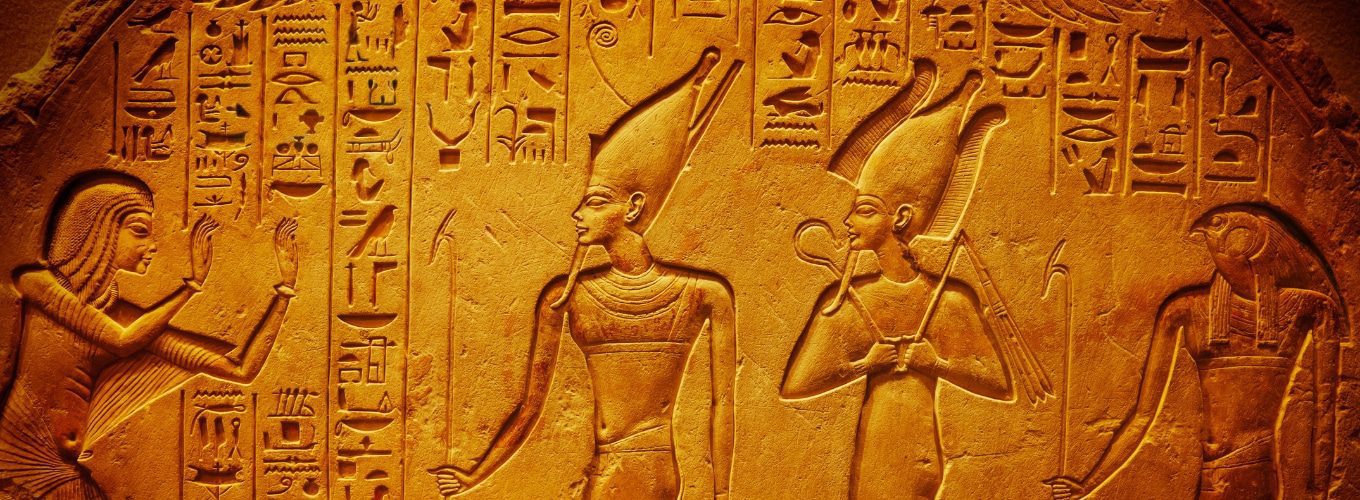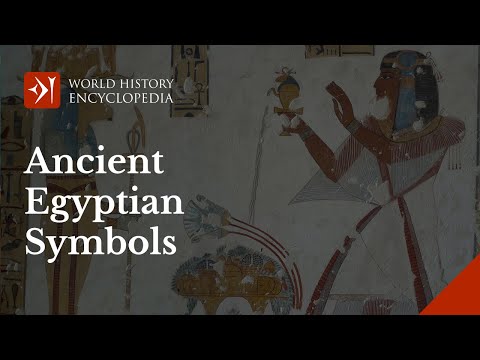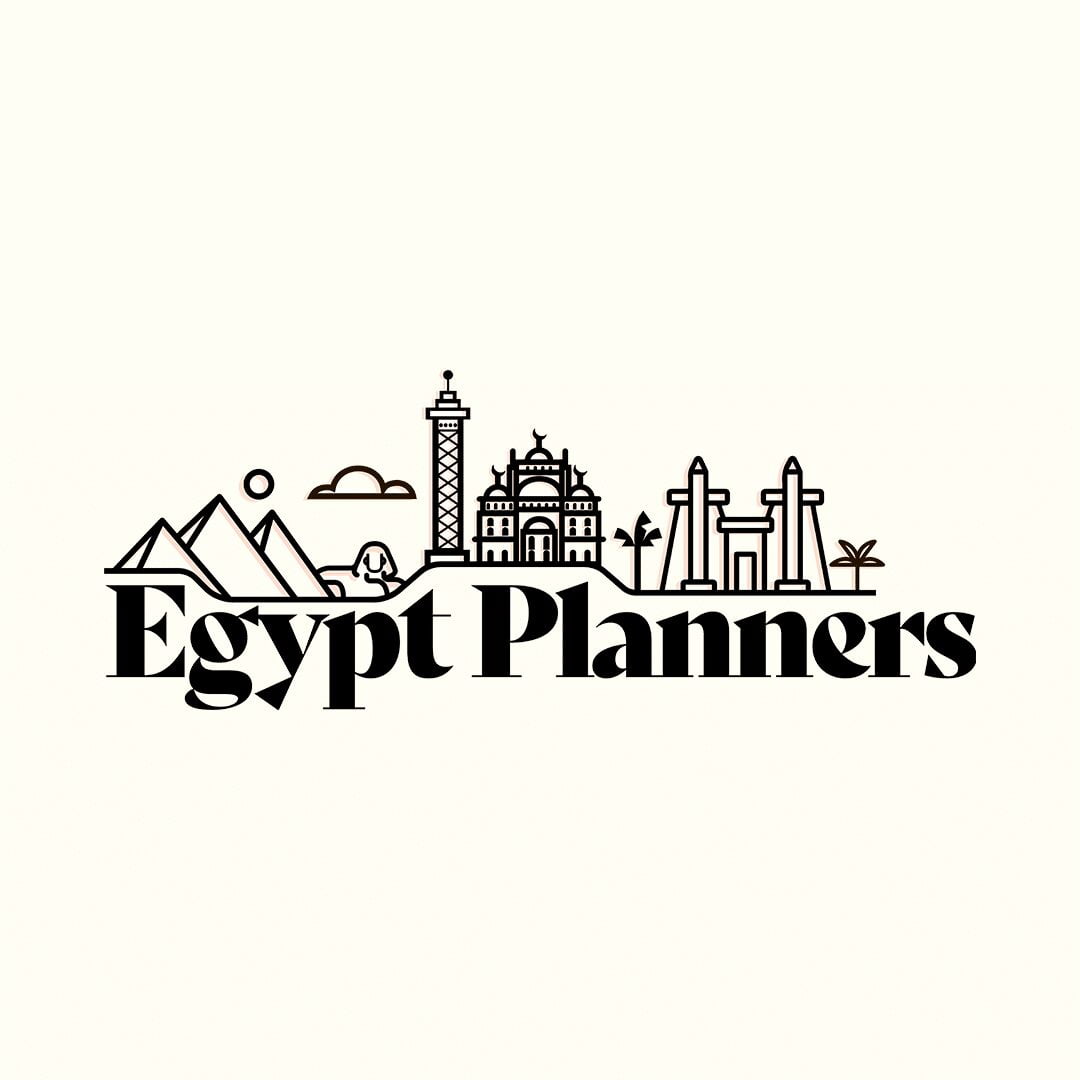What secrets do the ancient hieroglyphs of Egypt hold? From the enigmatic Ankh to the powerful Was Scepter, these symbols show us their deep spiritual beliefs. They also show us the roots of their lasting culture. Ancient Egyptian symbols were key to their culture and daily life. They used a complex system of hieroglyphics, seen as the “Words of the Gods”. These symbols were vital for recording important events and beliefs.
The Egyptians saw life as part of a bigger journey. They believed their symbols held deep meaning and importance. These symbols showed deities, royalty, the afterlife, and nature. They were more than just decorations. They helped keep ancient Egyptian culture alive.
Today, these symbols still fascinate scholars, artists, and fans. They offer a peek into ancient Egyptian life. The hieroglyphic system is now a symbol of their beliefs and culture. Let’s explore the world of the most important ancient Egyptian symbols together. We’ll learn about the symbols and what they mean.
Don’t miss out on our All inclusive Vacations to Egypt to discover the secrets of Egyptian symbols.
Key Takeaways
- Ancient Egyptian symbols, shown as hieroglyphs, were key to their culture. They told of history, spiritual beliefs, and rituals.
- These symbols stood for life, death, rebirth, power, protection, and the afterlife. They show the deep spirituality of the ancient Egyptians.
- Important symbols like the Ankh, Djed, Eye of Horus, Scarab, and Was Scepter were used in art, architecture, and religious acts.
- The hieroglyphic system was seen as the “Words of the Gods.” It helped pass on knowledge and traditions.
- Learning about these symbols helps us understand the ancient Egyptian worldview and beliefs.
Unveiling the Mysterious Symbols of Ancient Egypt
Ancient Egypt was full of symbols that told deep stories. They used a special language that showed their beliefs in religion, politics, and culture. These symbols still fascinate experts and fans today, showing us the rich world of Egyptian mythology.
The ancient Egyptian gods and goddesses were key to their culture. Each god had a symbol that meant a lot. The Ankh symbol meant life and new beginnings. The Eye of Horus was about power and safety.
Egyptian hieroglyphics were a special way of writing. They turned everyday things into sacred symbols. Symbols like the sun and the scarab beetle told stories of beliefs and traditions that still interest us today.
| Symbol | Meaning | Significance |
|---|---|---|
| Ankh | Life, protection, faith, energy, transformation, light, fertility | Associated with the goddess Isis, the Ankh symbol was commonly found in ancient Egyptian tombs and temples. |
| Eye of Horus | Protection and health | Represented healing and protection, often used as an amulet to ward off evil and offer safety. |
| Eye of Ra | Sun | Symbolized the sun’s power and authority, associated with the sun god Ra. |
| Ouroboros | Cycle of life and rebirth | Depicted as a snake eating its tail, symbolizing the eternal cycle of life, death, and rebirth. |
| Amenta | Land of the Dead | Represented the underworld or the afterlife in ancient Egyptian mythology. |
| Scarab Symbol | Transformation | Symbolized resurrection, renewal, and protection, often used in amulets and jewelry. |
| Djed Pillar | Strength and stability | Represented the backbone of Osiris, symbolizing stability and endurance. |
| The Tyet Symbol | Feminism | Associated with the goddess Isis, often linked to protection and life. |
| Symbol of Ka | Soul | Represented the spiritual essence or vital force of an individual. |
| Ba Symbol | Physical soul and rebirth | Depicted the personality or spirit that could travel between the living world and the afterlife. |
| Feather of Maat | Justice and truth | Associated with the goddess Maat, used to measure the purity of a soul in the afterlife. |
| Deshret Symbol | Lower Egypt | Represented the Red Crown of Lower Egypt, symbolizing authority and control over the region. |
| Hedjet Symbol | Upper Egypt | Represented the White Crown of Upper Egypt, signifying rule over the region. |
| Pschent Symbol | Unity of Egypt | Combined the Deshret and Hedjet crowns, symbolizing the unification of Upper and Lower Egypt. |
| Shen Symbol | Divinity and protection | Circular symbol representing eternity and protection, often depicted with gods and goddesses. |
| Uraeus | Power for gods & pharaohs | Represented the cobra, a symbol of sovereignty, royalty, and divine authority. |
| Seba | Star-gods or constellations | Represented stars, guiding the deceased to the afterlife and symbolizing creation. |
| Hekha and Nekhakha | Power of kingship | Represented the crook and flail, symbols of leadership and royal authority. |
| Menat | Prosperity, fertility, and fortune | Worn as a necklace, symbolizing fertility, joy, and good fortune. |
| Was Scepter | Rule of the gods | Symbol of divine power, authority, and control, often held by gods and kings. |
| Primordial Hill | Process of creation | Represented the mound from which the first god, Atum, created himself in Egyptian mythology. |
| Khepresh | Ceremonial & war | Blue crown worn by pharaohs during battles and ceremonies, symbolizing military power. |
| Tree of Life | Destiny & eternal life | Represented knowledge, enlightenment, and the eternal life cycle. |
| Ieb | Heart | Symbolized the heart, which was believed to be the center of emotion, intellect, and will in a person. |
| Akhet | Horizon of the sun | Symbolized the sunrise or sunset, representing the cycle of life and rebirth. |
| Atef | Egyptian deity Osiris | A crown worn by Osiris, symbolizing his divine authority over the underworld. |
| Canopic Jars | Mummification and protection | Used to store the internal organs of mummies, protecting them in the afterlife. |
| Sesen | Sun, rebirth, and creation | Represented the lotus flower, symbolizing the sun, rebirth, and creation. |
| Sistrum | Music and good luck | A musical instrument associated with Hathor, symbolizing joy and divine harmony. |
| Winged Sun | Solar power and eternity | Represented the sun’s power and protection, often used as a protective symbol in temples and tombs. |
List of Top 30 Ancient Egypt Symbols with Its Meaning
Ancient Egyptian symbols hold immense significance and offer valuable insights into the beliefs and culture of this ancient civilization. These symbols are not merely decorative but carry profound meanings that were deeply ingrained in every aspect of Egyptian life. Here are some of the most important ancient Egyptian symbols and their meanings.
1- Ankh – Egyptian Symbol of Life
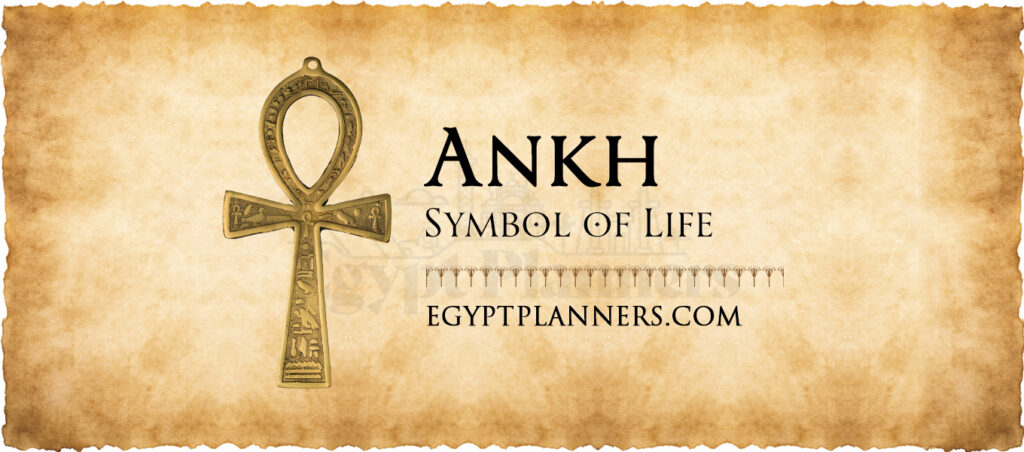
The Ankh is an important ancient Egyptian symbol. It stands for life, vitality, and eternal life. It looks like a cross with a loop at the top. Gods and goddesses often hold it, showing they can give eternal life.
The Ankh was used in many ways, like in rituals and everyday items. It was thought to give divine protection and blessings. Its roots go back to ancient Egyptian myths, linked to Osiris and Isis. These gods ruled over life and death.
Today, the Ankh still fascinates people all over the world. It shows the enduring power of ancient symbols.
- Origin/Evolution: The ankh’s exact origins are uncertain, but it appears as early as the First Dynasty (c.3150 BCE). Its enduring meaning as a symbol of life was consistently present throughout Egyptian history.
- Mythological/Ritual Usage: Associated with deities like Isis and Osiris, the ankh was often depicted in scenes offering the breath of life. It held significance in funerary rituals, ensuring the deceased’s eternal existence.
2- Eye of Horus – Symbol of Protection and Health
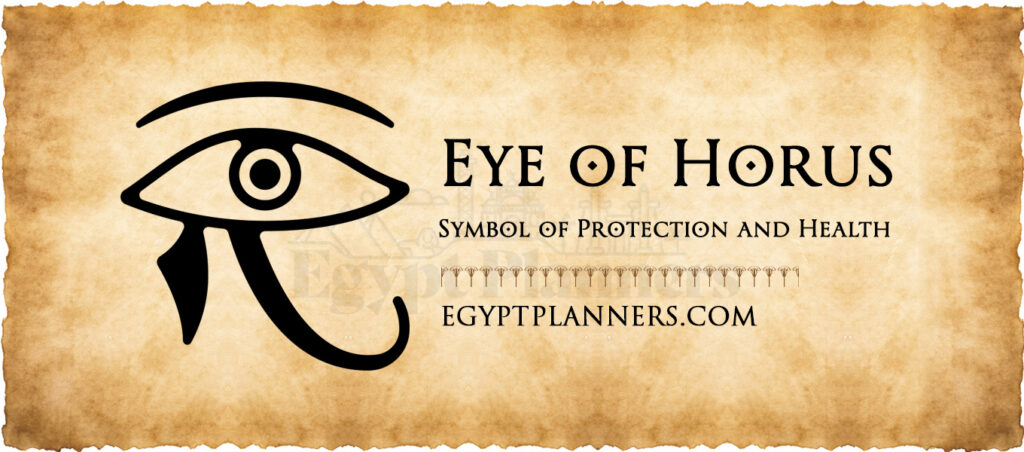
The Eye of Horus is a symbol of protection and healing in ancient Egypt. It looks like a human eye with markings like a falcon’s eye. This represents the god Horus’ sharp vision and watchful eye.
Myth says Horus lost his eye in a fight with his uncle Seth. But he got it back, showing balance and order returned. The Eye of Horus was thought to keep away evil spirits and protect from harm. It also brought good health and energy to those who wore it.
It’s often seen in amulets, jewelry, and temple carvings. This symbol showed divine protection and kindness.
- Origin/Evolution: Linked to the myth of Horus and Seth battling for the throne, the Eye of Horus appears as a fully developed symbol from the Old Kingdom (c. 2686–2181 BCE) onwards.
- Mythological/Ritual Usage: Egyptians wore amulets of the eye believing it offered healing and protective properties.
3- Eye of Ra – Ancient Egyptian Symbol of the Sun
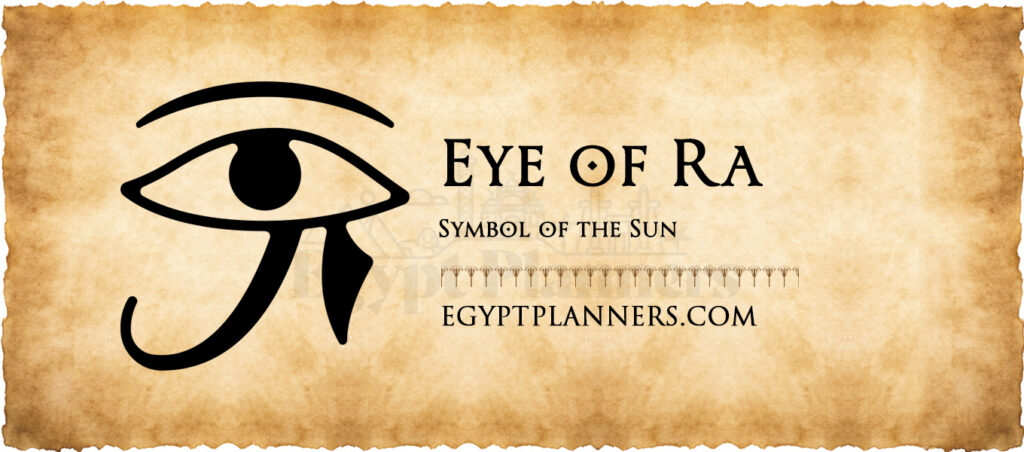
The Eye of Ra is a symbol of the sun god Ra’s power and protection. It shows Ra’s watchful eye with sun rays and a cobra. This symbol means Ra is always watching over us.
It fights off darkness and lights the way to being good. The Eye of Ra also stands for justice. Ra uses it to tell truth from lies in the afterlife.
This symbol was on temples, tombs, and royal clothes. It showed the sun’s power and the pharaoh’s right to rule wisely and kindly.
- Origin/Evolution: The Eye of Ra is connected to goddesses like Hathor, Wadjet, and Sekhmet. This shows the feminine side of the sun’s power. It’s also tied to myths about the sun’s destructive power.
- Mythological/Ritual Usage: The Eye was used for protection against evil. But it also warned of fiery punishment. It had spells and amulets to keep the wearer safe.
Check your comprehensive guide about Eye of Horus vs Eye of Ra
4- Ouroboros – Symbol of the Cycle of Life and Rebirth
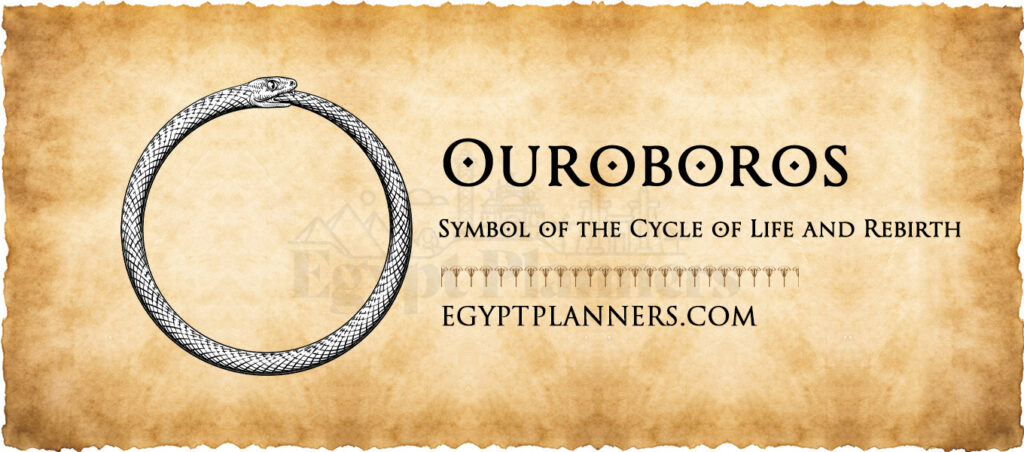
The Ouroboros is a symbol of eternal renewal and the cycle of life in ancient Egyptian culture. It shows a serpent or dragon eating its tail. This symbolizes the endless cycle of life, death, and rebirth.
It shows how everything is connected. Each end leads to a new start in a cycle of creation and destruction. In ancient Egyptian myths, it was linked to the sun god Ra. Ra traveled through the underworld at night and was reborn at dawn.
The Ouroboros was found in tombs, temples, and sacred texts. It showed the eternal nature of the universe and the soul’s journey through life and death.
- Origin/Evolution: The Ouroboros first appeared in Egyptian funerary texts during the New Kingdom (1550-1069 BCE). It became more popular in the Greco-Roman Period, tied to alchemy and mysticism.
- Mythological/Ritual Usage: It symbolized the sun’s daily cycle and the ideas of eternity and return. It was used in spells and amulets for rebirth and the afterlife.
5- Amenta – the Symbol of the Land of the Dead
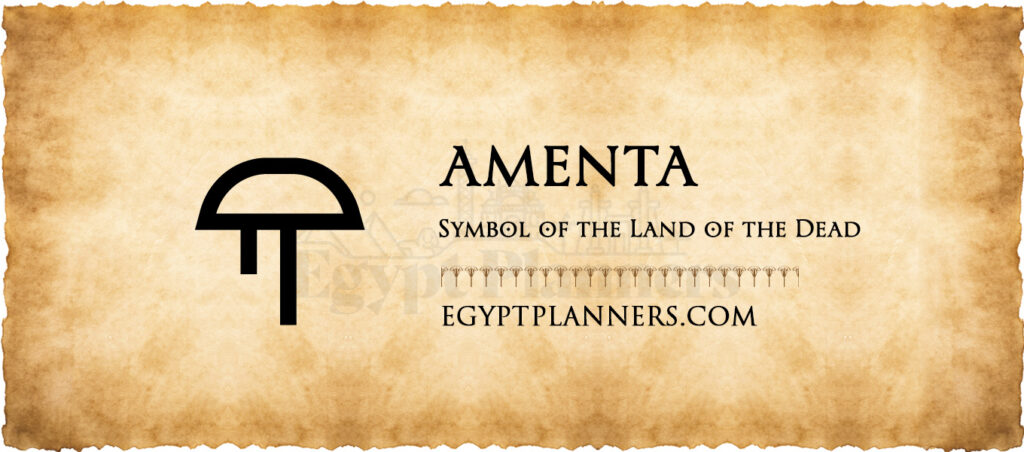
Amenta, also known as the Duat, is the ancient Egyptian afterlife. It’s a mysterious underworld with gods, spirits, and judges. Here, the soul is judged and purified before reaching eternal bliss or punishment.
Amenta shows the soul’s journey from life to the spiritual realm. It’s where the soul meets the gods and ancestors in an eternal cycle. This belief is seen in funerary texts, tomb paintings, and rituals.
- Origin/Evolution: Amenta, meaning “the hidden place,” was thought of from the start of Egyptian history. Its vision grew more detailed in the New Kingdom’s funerary texts.
- Mythological/Ritual Usage: The dead pharaoh was seen as Osiris, ruler of Amenta. The Book of the Dead and other texts gave detailed guides for the underworld’s dangers.
6- Scarab Symbol – the Symbol of Transformation
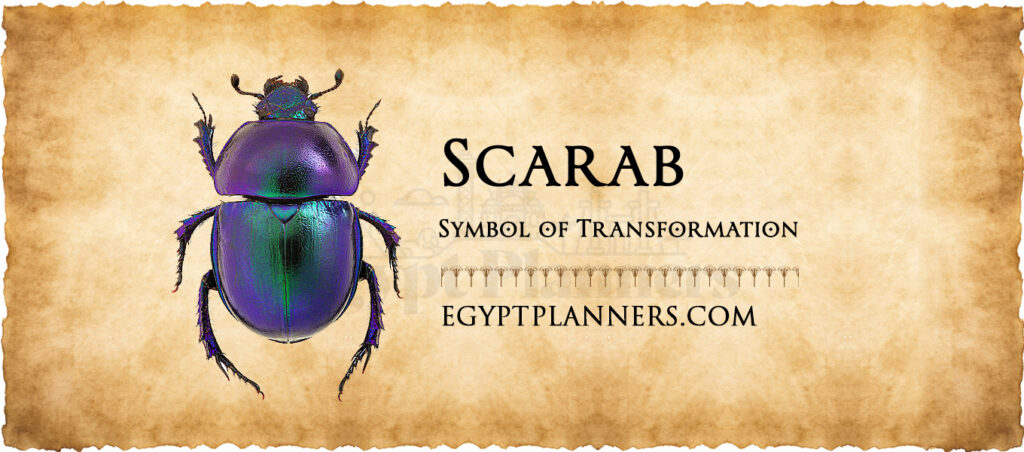
The scarab beetle was a big deal in ancient Egyptian culture. It stood for rebirth, change, and new life. It was known for coming from dung and laying eggs, showing the cycle of life and renewal.
It was linked to the sun god Ra, who made the sun move across the sky every day. Scarab amulets were put on mummies’ hearts to help them get to the afterlife safely. This symbol showed the endless cycle of life, death, and rebirth.
Every end leads to a new start in this never-ending cycle of creation and renewal.
- Origin/Evolution: Scarab imagery goes way back to the Old Kingdom. It got closer to the god Khepri, who was like the rising sun, over time.
- Mythological/Ritual Usage: Scarabs were worn as amulets for protection. They were key in funerary rites, standing for the heart and helping the dead change for the afterlife.
7- Djed Pillar – Symbol of Strength and Stability
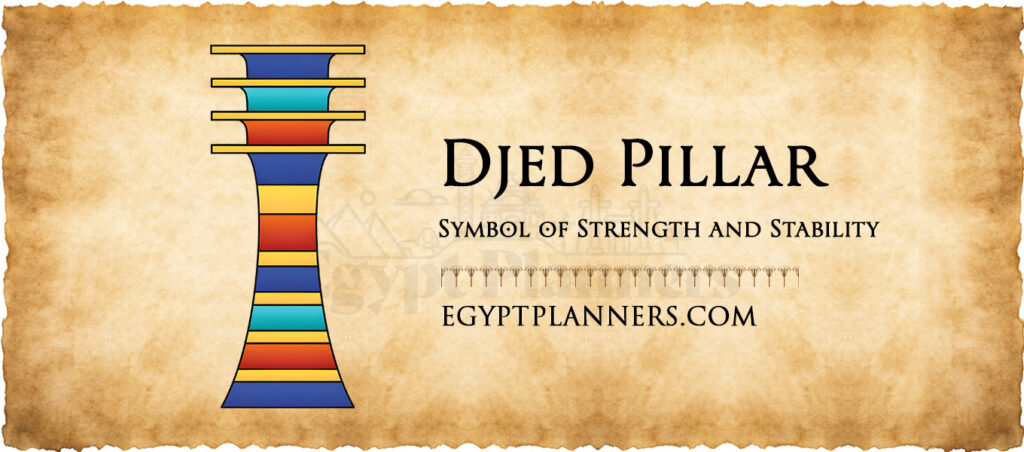
The Djed pillar is a symbol of stability and endurance in ancient Egyptian culture. It looks like a column with four bars and a crown-like top. This shape represents the backbone of Osiris, the god of life after death.
This symbol shows the stability of the universe and the strength of the human spirit. It’s seen in temples, tombs, and art. It shows the Egyptians’ belief in eternal life and the promise of rebirth after death.
- Origin/Evolution: This symbol is very old, maybe even before the first pharaohs. It became closely tied to Osiris by around 2050-1650 BCE.
- Mythological/Ritual Usage: The “raising of the Djed” was a big festival. It meant keeping the land stable and renewing Osiris’s power.
8- The Tyet Symbol: A Representation of Feminism
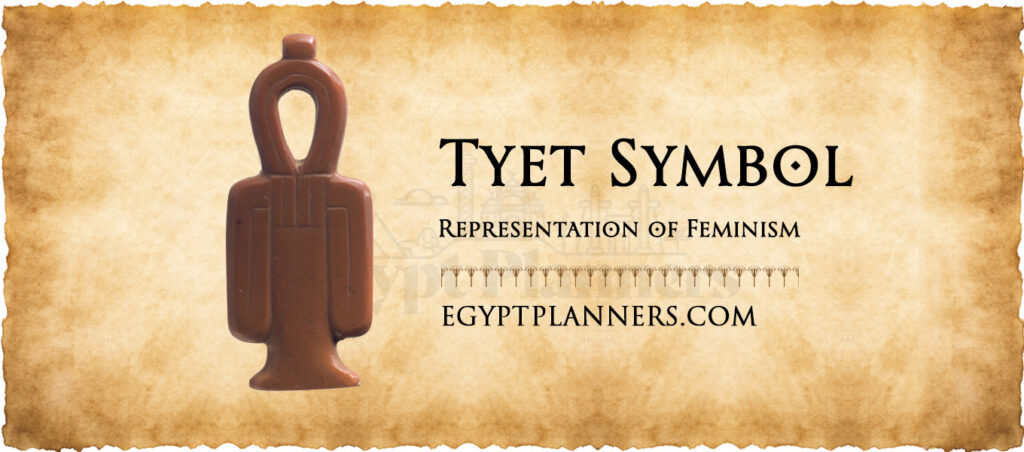
The Tyet symbol is also known as the Knot of Isis or the Blood of Isis. It stands for femininity, fertility, and protection in ancient Egyptian culture. It looks like an upside-down triangle with a loop at the top. This shape shows the menstrual blood of the goddess Isis and her role as a mother and protector.
The Tyet symbolizes the power of women to create and care for life. It also shows the goddess’s ability to keep her children safe from harm and evil. You can find it in amulets, jewelry, and temple reliefs. It shows the lasting influence and protection of the divine feminine in the universe.
- Origin/Evolution: It first appeared in the New Kingdom. Its look is similar to the “Isis knot” on clothes, linking it to the goddess. Its meaning is debated but is closely tied to feminine power and protection.
- Mythological/Ritual Usage: The Tyet was used in everyday amulets and for funerals. It sought blessings and protection from Isis, especially for childbirth and the afterlife journey.
9- Symbol of Ka: A Representation of the Soul
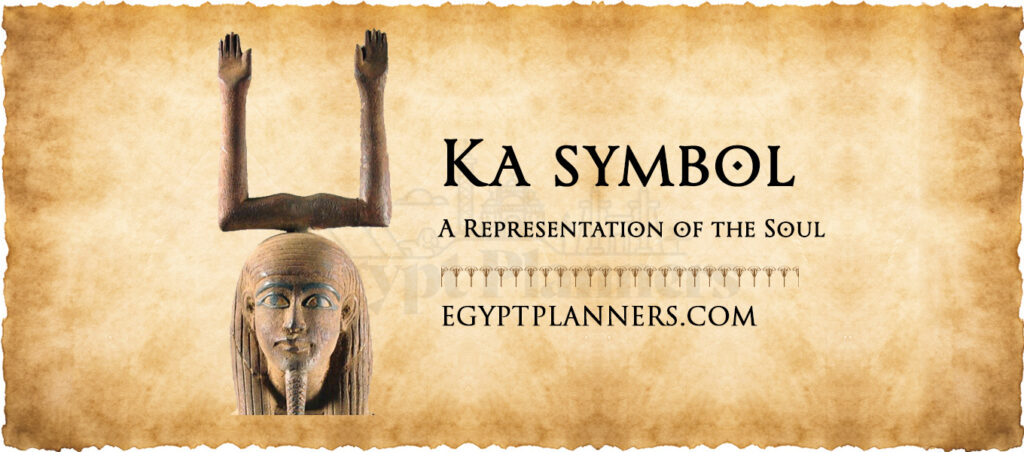
The symbol of Ka stands for the soul or life force in ancient Egypt. It looks like two upraised arms with curved ends. It was seen as the spiritual essence that kept a person alive and after death.
The Ka was linked to the Ba, another soul part. It was shown in tombs and temples. There, it was thought to feed and protect the dead in the afterlife.
The Ka symbol shows the soul’s eternal nature and its link to the divine. It shows the ancient Egyptians’ belief in life after death.
- Origin/Evolution: A key concept from early Egyptian belief, the Ka was one of multiple parts of the soul. The hieroglyph itself is present from the Old Kingdom onwards.
- Mythological/Ritual Usage: Ensuring the Ka had sustenance in the afterlife was part of funerary rites. Tomb offerings and images of food “fed” the Ka of the deceased.
10- Ba Symbol: Representing Physical Soul and Rebirth
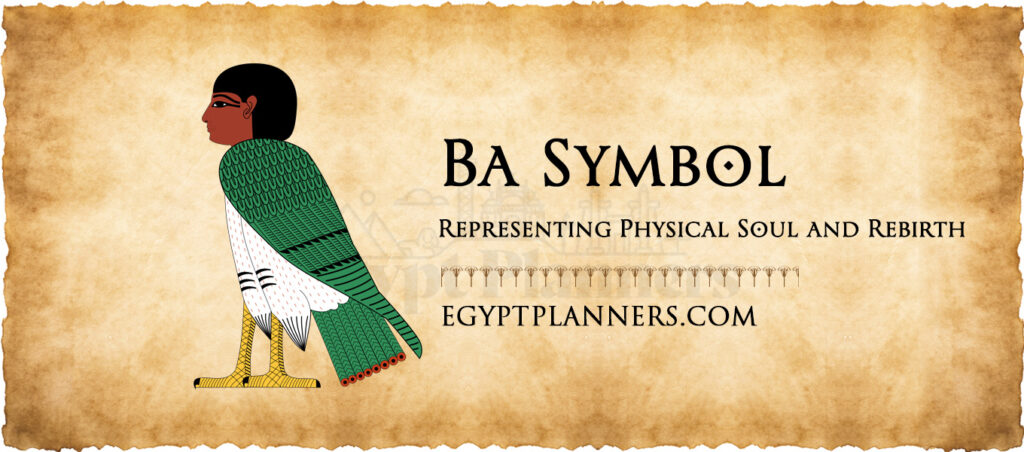
The Ba symbol is an ancient Egyptian hieroglyph that shows the soul’s physical form and its journey after death. It looks like a human-headed bird with wings outstretched. The Egyptians thought it left the body at death.
The Ba symbol was linked with rebirth and change. The soul aimed to join with the divine after death. It was often seen in art and temple carvings, showing the Egyptians’ belief in the soul’s afterlife journey.
- Origin/Evolution: Like the Ka, the Ba was key to the Egyptian soul from the Old Kingdom on. Bird-like depictions of the Ba became more common later.
- Mythological/Ritual Usage: The Book of the Dead had spells to help the Ba leave the tomb and return to the body each night. This showed the Ba’s ongoing life.
11- Feather of Maat: Representing Justice and Truth
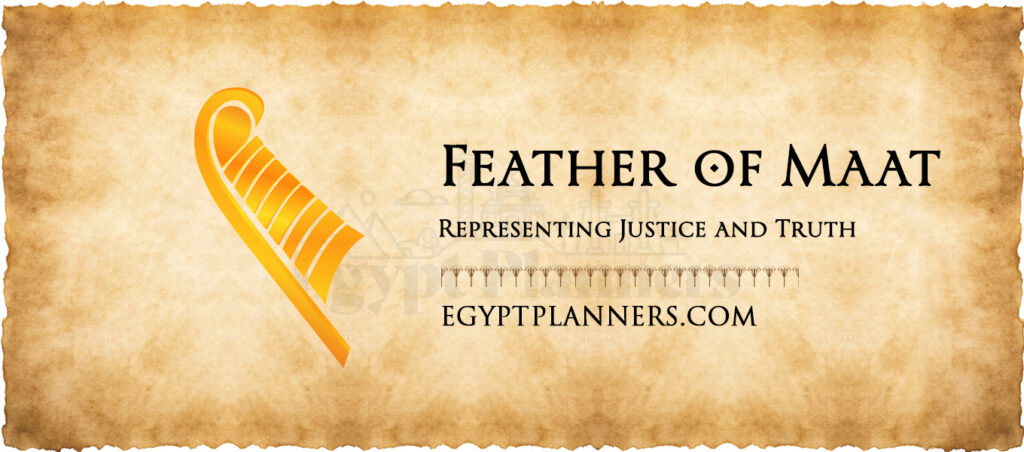
The Feather of Maat is an ancient symbol from Egypt, standing for truth, justice, and balance. It is linked to the goddess Maat, who symbolized order and truth. In the afterlife, the heart was weighed against the Feather to see if the soul was worthy of eternal life.
If the heart was lighter, the soul could enter the afterlife. But if it was heavier, a monster would eat it. This symbol shows the value of living a good life and the Egyptians’ belief in the universe’s balance.
- Origin/Evolution: Maat, the goddess of truth and order, is personified from early Egyptian history. The feather becomes her iconic symbol, emphasizing the concept of balance central to both life and the afterlife.
- Mythological/Ritual Usage: After death, the heart was believed to be weighed against her feather. Only a heart lighter than the feather indicated a life lived by Maat, allowing the individual to proceed to the afterlife.
12- Deshret Symbol: A Representation of Lower Egypt
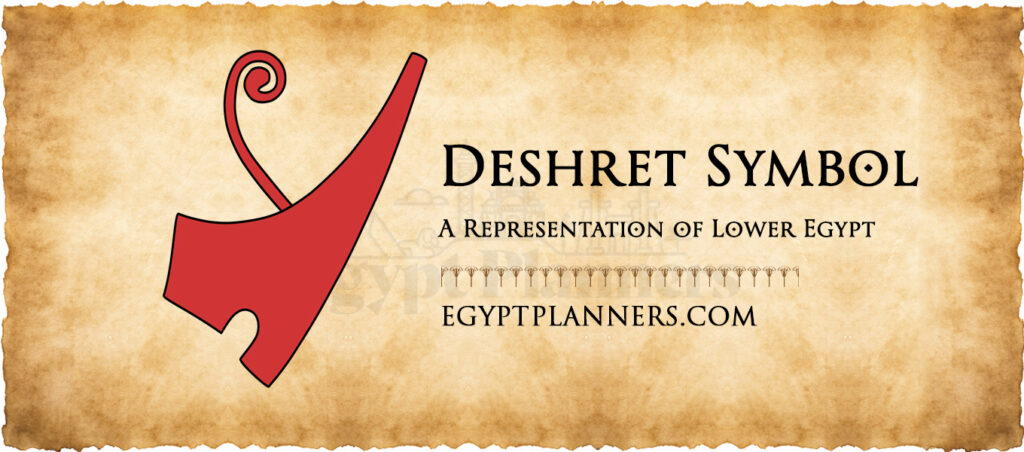
The Deshret symbol is an ancient Egyptian symbol that represents the Red Crown of Lower Egypt. It looks like a flat-topped crown with a curving line at the base. This design symbolizes the fertile delta region of the Nile River.
The Deshret symbol was worn by pharaohs and shown in royal regalia. It showed their authority over Lower Egypt. It also stood for the unity and power of the kingdom. Plus, it showed the pharaoh’s divine right to rule over the land and its people.
- Origin/Evolution: A very ancient symbol, possibly pre-dating the unification of Egypt. It becomes closely associated with the goddess Wadjet, protector of Lower Egypt.
- Mythological/Ritual Usage: Worn by pharaohs as part of their regalia, but also featured on depictions of Wadjet. It represents one-half of the unified Egyptian kingdom
13- Hedjet Symbol: Representing the Kingdom of Upper Egypt
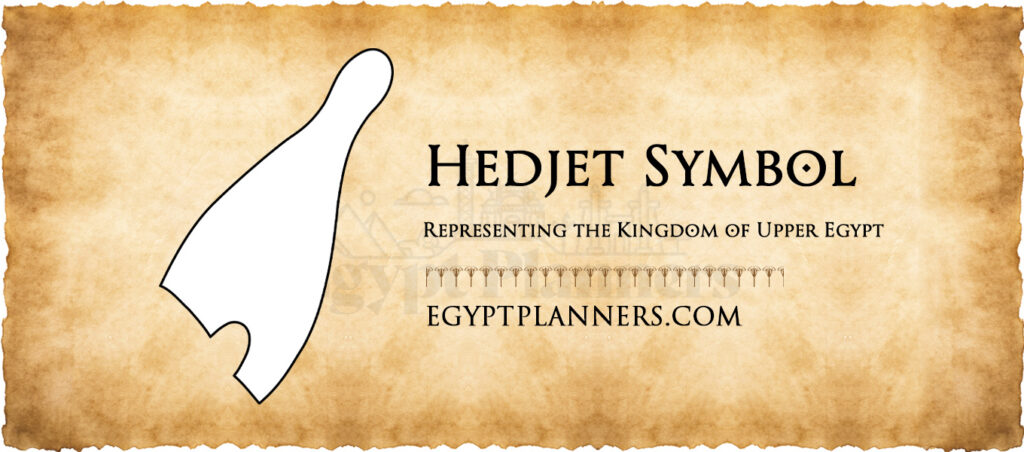
The Hedjet symbol is an ancient Egyptian hieroglyph. It represents the White Crown of Upper Egypt. It looks like a tall, conical crown with a knob at the top.
This symbol was worn by pharaohs and shown in royal regalia. It showed their power over Upper Egypt. It also showed their role as the kingdom’s protector and ruler.
The Hedjet symbol shows the ancient Egyptians’ belief in the divine origin of kingship.
- Origin/Evolution: Like the Deshret, it’s a very old symbol associated with the prehistoric kingdoms of the Nile Valley. The goddess Nekhbet, protector of Upper Egypt, is often shown wearing the Hedjet.
- Mythological/Ritual Usage: Vital in royal iconography, signifying the pharaoh’s dominion over the southern lands of Egypt.
14- Pschent Symbol: Representing the Unity of Egypt
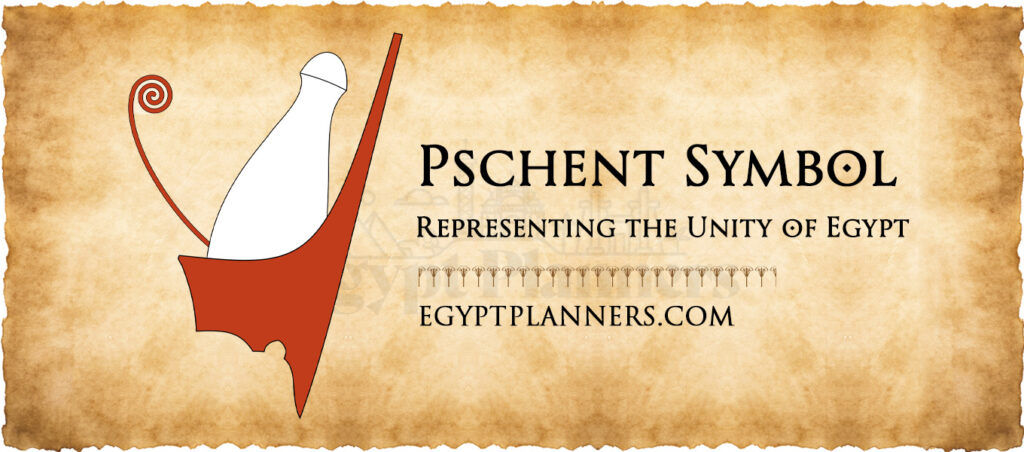
The Pschent symbol is an ancient Egyptian hieroglyph. It shows the Double Crown of Egypt, made from the Deshret and Hedjet crowns. This symbol means the joining of Upper and Lower Egypt under one ruler, starting the dynastic period.
The Pschent symbol was worn by pharaohs to show their divine right to rule and make laws. It shows the kingdom’s unity and the pharaoh’s power over the land and people.
- Origin/Evolution: The combined Pschent crown appears once Egypt is united, likely during the Early Dynastic Period. It becomes THE symbol of pharaonic power.
- Mythological/Ritual Usage: There’s no ritual context outside of the pharaoh wearing it. The symbolism instead is purely about the ruler’s dominion over both parts of the land.
15- Shen Symbol: Representing Divinity and Protection
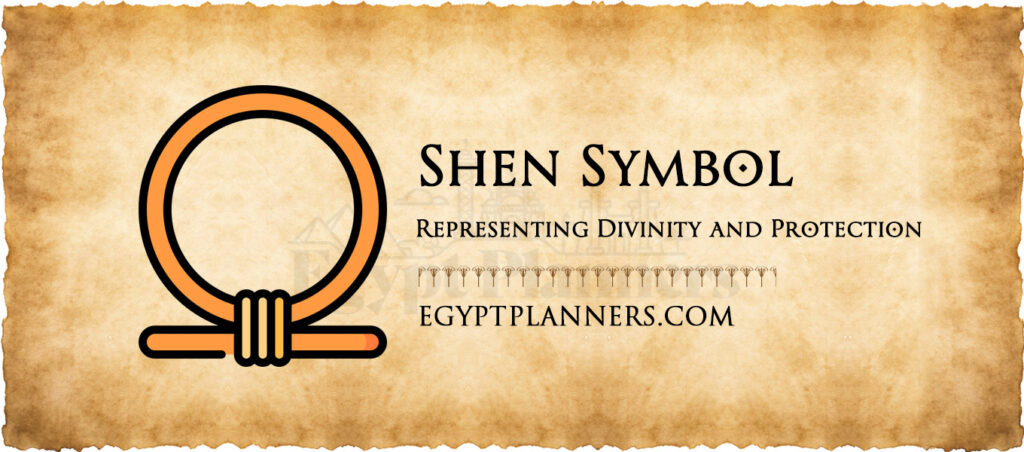
The Shen symbol is an ancient Egyptian hieroglyph. It means eternity, infinity, and divine protection. It looks like a looped rope or circle with a horizontal bar at the bottom.
This symbol shows eternal life and the cycle of existence. The Egyptians used it in amulets, jewelry, and royal cartouches. It kept evil forces away and protected against time.
It shows the soul’s eternal nature and its link to the divine. It also shows the Egyptians’ belief in life after death.
- Origin/Evolution: Meaning “encircle,” it appears early in Egyptian history. Its form evokes the circular path of the sun, linking it with eternity.
- Mythological/Ritual Usage: Amulets in the shen shape were common for protection. It’s also found encircling names in cartouches to ward off evil.
16- Uraeus – Symbol of Power for Gods & Pharaohs
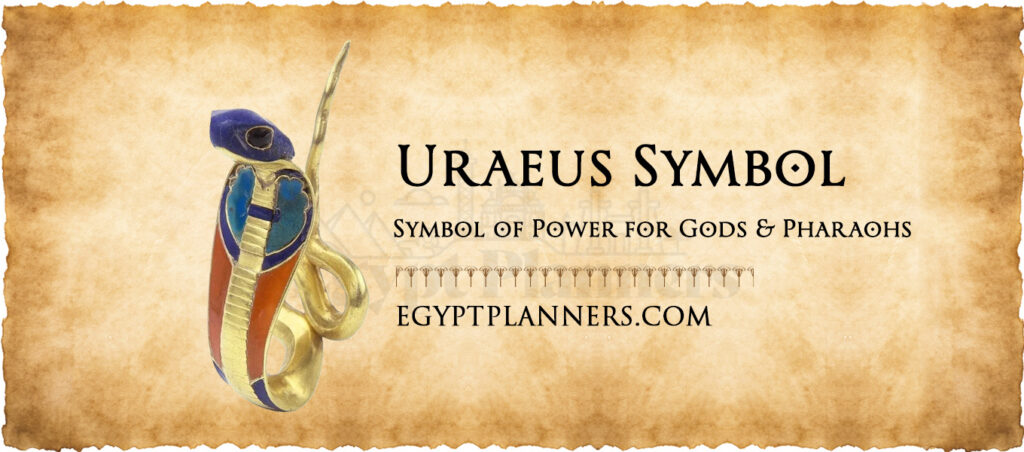
The Uraeus is a symbol of divine authority and protection in ancient Egyptian culture. It is shown as a cobra ready to strike. This symbol was linked to the goddess Wadjet and the sun god Ra.
It showed their power and protection over the kingdom. Pharaohs wore it as a crown and on royal regalia. This showed their divine right to rule and protect the land.
The Uraeus symbolizes the pharaoh’s authority as a god-king. It shows his power to defend the kingdom from threats.
- Origin/Evolution: In early Egyptian history, cobra imagery was associated with protection and the sun goddess Wadjet. Later, the Uraeus becomes closely linked with kingship, representing both power and protection.
- Mythological/Ritual Usage: The Uraeus symbolized the fiery Eye of Ra, linked to goddesses like Wadjet and Hathor. Pharaohs wore it as a declaration of their right to rule as protectors of the land.
17- Seba – Symbol of Star-Gods or Constellations
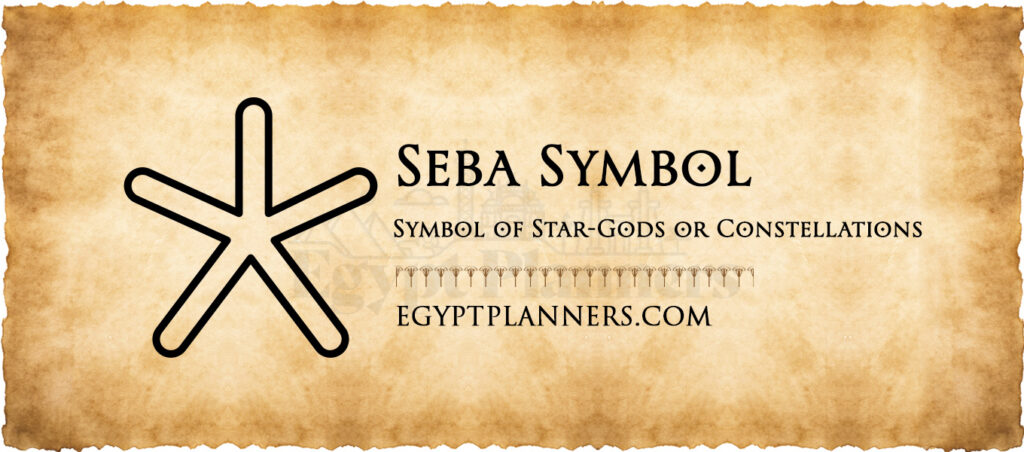
The Seba symbol is linked to the star-gods or constellations in ancient Egyptian myths. It stands for the heavens and the stars that guided time and seasons. The goddess Nut was often seen with arms outstretched, showing the starry sky.
It was thought that souls would join the stars after death, shining forever in the sky. The Seba symbol shows the endless nature of the universe and the soul’s path after life. It also shows the Egyptians’ deep respect for the heavens and their belief in the stars’ power to guide and protect them.
- Origin/Evolution: Stars were very important from the start in Egypt. The Seba symbol is a simple way to show the stars in the sky.
- Mythological/Ritual Usage: It’s connected to the “followers of Osiris,” the stars that the dead join in the afterlife. It was seen a lot on the ceilings of temples.
18- Hekha and Nekhakha – Symbol of the Power of Kingship
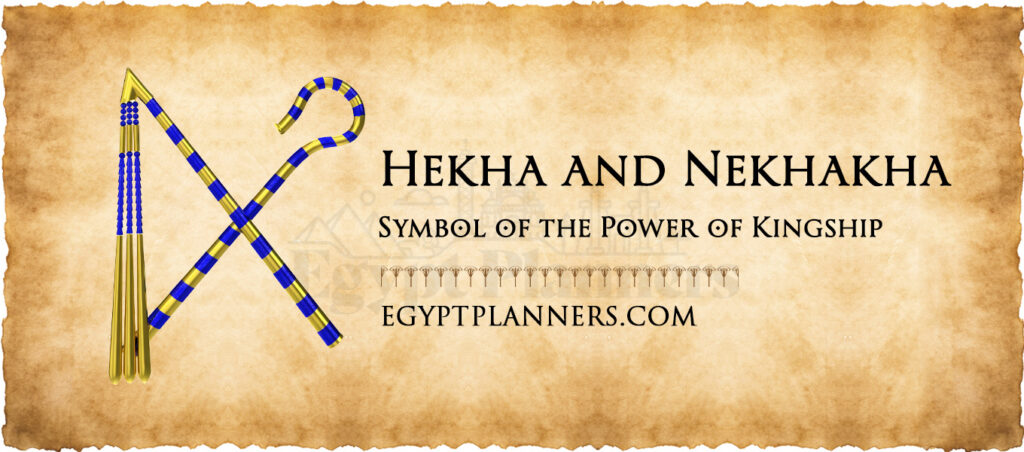
The Hekha and Nekhakha symbols are ancient Egyptian hieroglyphs. They show the symbols of kingship and authority. Hekha, the crook, means the pharaoh guides and protects his people like a shepherd.
Nekhakha, the flail, shows the pharaoh’s power to punish wrongdoers and keep order. Together, these symbols show the pharaoh’s divine right to rule and protect the kingdom. They show the ancient Egyptians’ belief in the divine origin of kingship.
- Origin/Evolution: These symbols appear very early and may have had practical origins linked to the role of a chieftain shepherding his people.
- Mythological/Ritual Usage: Vital parts of royal regalia, but also carried by gods like Osiris, emphasizing the link between the king and divine authority.
19- Menat – Symbol of Prosperity, Fertility, and Fortune
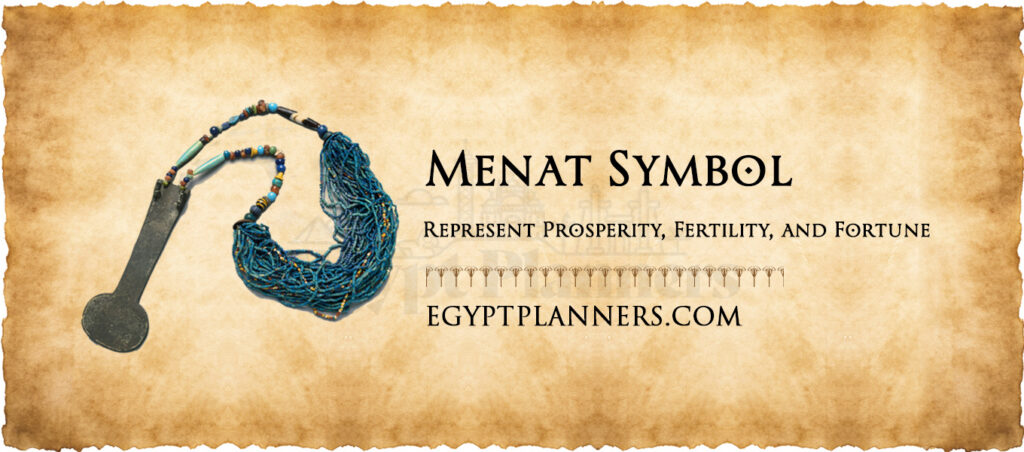
The Menat symbol is an ancient Egyptian symbol. It stands for prosperity, fertility, and fortune. It looks like a broad collar necklace with counterpoise beads.
Women wore the Menat during religious rituals and ceremonies. They did this to get the goddess Hathor’s blessings of fertility, abundance, and protection. It was thought to bring prosperity and good fortune to the wearer and their family.
The Menat symbol shows the ancient Egyptians’ respect for the goddess Hathor. They believed she could bring prosperity and blessings to their lives.
- Origin/Evolution: Appearing by the Middle Kingdom, it’s associated with the goddess Hathor, though its exact symbolism is debated. Its shape suggests ritual shaking and rattling.
- Mythological/Ritual Usage: Linked to joyful noisemaking and Hathor as the bringer of abundance. Shaking the Menat may have been connected to seeking the goddess’s favor.
20- Was Scepter – Symbol of the Rule of the Gods
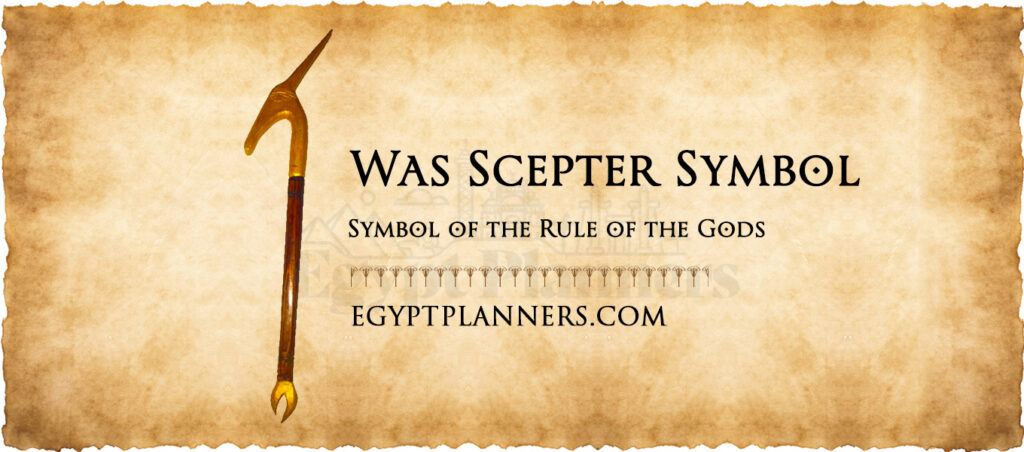
The Was scepter is an ancient Egyptian symbol of divine power and authority. It looks like a staff with a straight shaft and a forked end. This design shows control and power over chaos and disorder.
The Was scepter was linked to the gods and goddesses of ancient Egypt. They used it to keep order and justice in the universe. Pharaohs also used it to show they had the right to rule and make laws.
This symbol shows the ancient Egyptians believed in the rule of the gods. They thought the gods could keep the world in order and justice.
- Origin/Evolution: The Was scepter has been around since the Early Dynastic Period. It was a symbol of power for both gods and pharaohs. It showed they had divine authority over the world.
- Mythological/Ritual Usage: Gods are often shown holding the Was scepter. Kings received it as a sign of divine approval for their rule.
21- Primordial Hill – Symbol of the Process of Creation
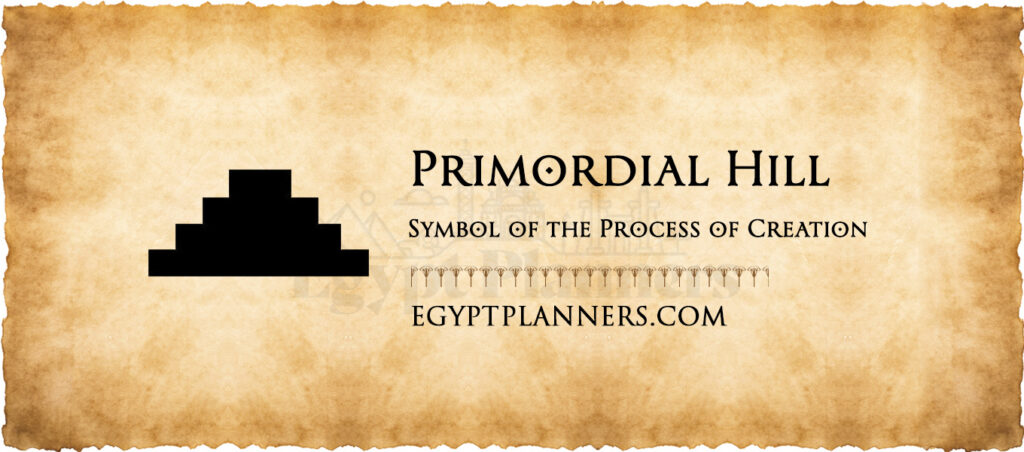
The Primordial Hill is an ancient Egyptian symbol. It represents the mythical mound that came out of chaos at creation’s start. This mound symbolizes Egypt’s fertile land, which grew from the Nile’s floods. It gave life and fertility to the people.
The Primordial Hill is linked to the god Atum. He was thought to have made the world from the primeval waters of Nun. This shows the Egyptians’ belief in creation’s cycle and life’s eternal renewal.
- Origin/Evolution: A key idea in Egyptian creation myths. Each major religious center had its own version of the myth. The local creator god rose from the hill at creation’s start.
- Mythological/Ritual Usage: The hill’s creation myths were key in temple rituals. They helped keep the world’s order alive with each telling.
22- Khepresh – Symbol of Ceremonial & War
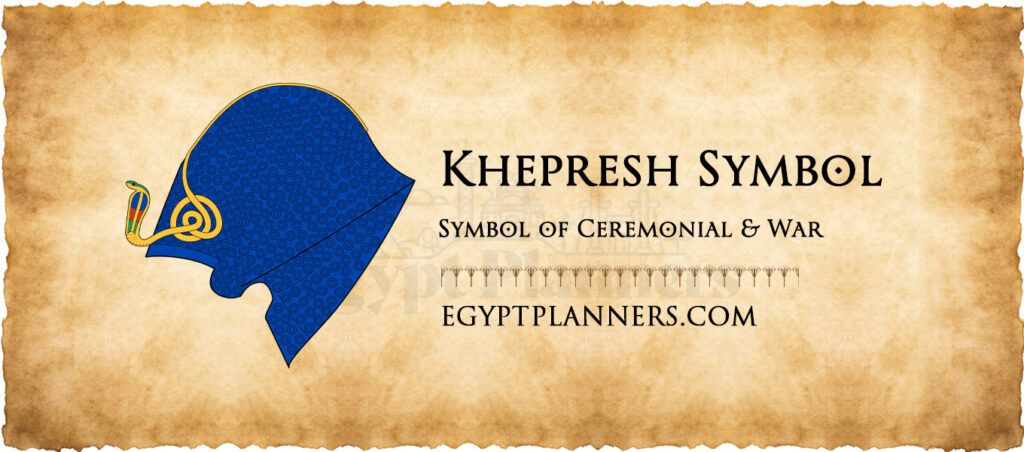
The Khepresh, also known as the Blue Crown or the War Crown, was a royal headdress in ancient Egypt. It was worn by pharaohs during ceremonies and military campaigns. It showed the pharaoh’s power as a divine ruler and warrior leader.
The Khepresh was made of gold and precious gems. These materials showed the pharaoh’s wealth and power. It was often seen in temple reliefs and royal statues. This showed the pharaoh’s role as a protector of Egypt’s sovereignty and divine order.
The Khepresh showed the ancient Egyptians’ respect for the pharaoh as a god-king. They believed he could defend the kingdom from enemies. He was seen as the one who kept the kingdom prosperous and secure.
- Origin/Evolution: The Khepresh started in the New Kingdom. It was inspired by earlier helmets but focused on the pharaoh’s power over enemies.
- Mythological/Ritual Usage: Pictures often show a pharaoh getting the Khepresh from a god. This showed that their authority and military strength were divine.
23- Tree of Life – Symbol of Destiny & Eternal Life
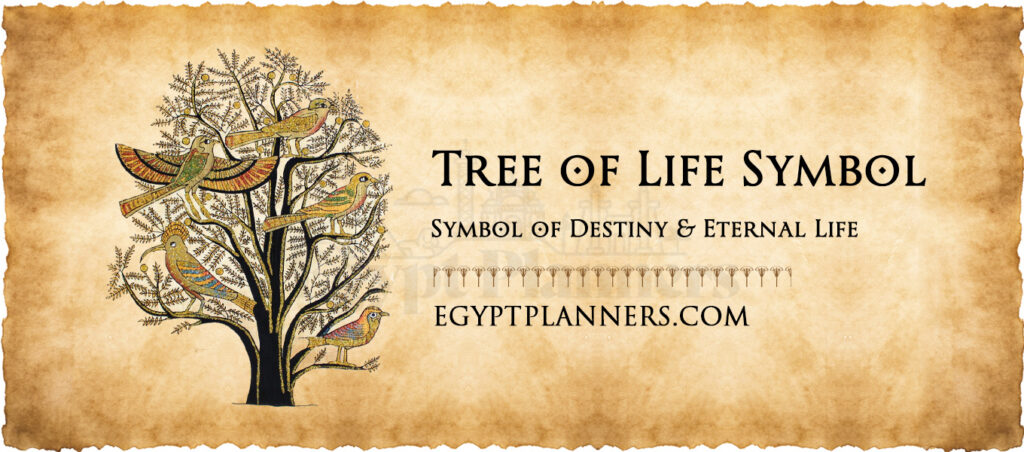
The Tree of Life is an ancient Egyptian symbol. It shows how all living things are connected. It also shows the cycle of life, death, and rebirth.
Its branches reach up to the sky and its roots go deep into the earth. This symbolizes the divine order and harmony of the universe. The goddess Hathor was linked to it, believed to nurture and sustain life on earth.
The Tree of Life was seen in funerary art and temple reliefs. It showed the journey of the deceased to the afterlife. It also symbolized their eternal reunion with the divine.
This symbol shows the Egyptians’ deep respect for nature. They believed in the continuity of existence after death.
- Origin/Evolution: Linked to the early goddess Nut, the tree was seen as a source of life and protection. Its connection to the afterlife grew stronger over time.
- Mythological/Ritual Usage: In tombs, images show the deceased getting nourishment from the tree. This ensured their eternal well-being.
24- Ieb – Symbol of the Heart
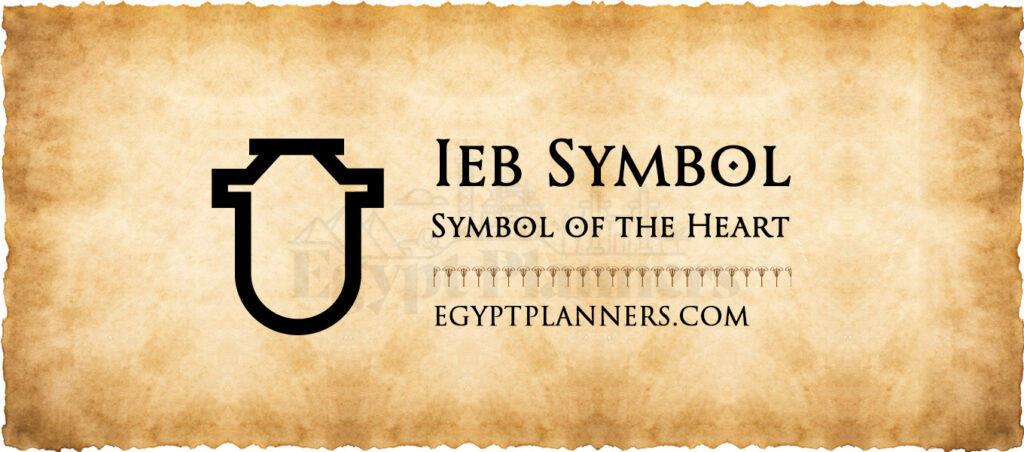
The Ieb symbol is an ancient Egyptian hieroglyph that looks like a heart. It shows the heart’s role in intelligence, emotion, and consciousness. It was important in ancient Egyptian beliefs about the afterlife.
The Ieb symbol was linked to the god Osiris. He weighed the hearts of the dead against the Feather of Maat. This decided if they were worthy for eternal life.
The symbol was also seen in funerary art and amulets. It showed the dead’s wish for a pure heart in the afterlife. The Ieb symbol highlights the Egyptians’ belief in moral purity and integrity.
They believed these qualities were key for eternal peace and happiness in the divine realm.
- Origin/Evolution: A key concept from the earliest periods of Egyptian belief, the Ieb was considered a vital aspect of the soul, necessary for the afterlife journey.
- Mythological/Ritual Usage: Scenes of the heart being weighed are ubiquitous in funerary texts. Spells were inscribed on amulets called heart scarabs to protect and guide the heart during judgment.
25- Akhet – Symbolizing the Horizon of the Sun
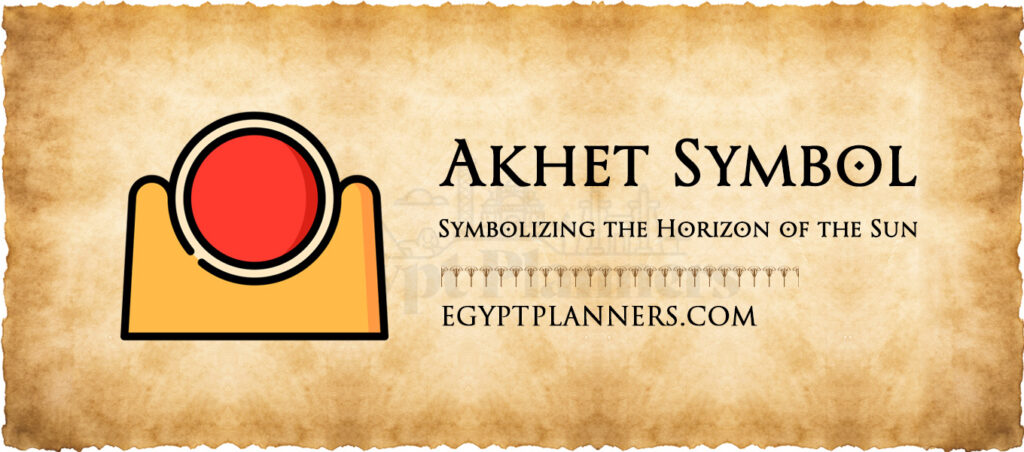
The Akhet symbol is about the sun’s horizon in ancient Egyptian myths. It shows the sun god Ra’s daily path from sunrise to sunset. This symbol means rebirth and renewal, as the sun dies and is reborn every day.
It also links to the afterlife, guiding souls to the underworld. The Akhet was seen in temples, tombs, and royal items. It shows the sun’s key role in Egyptian beliefs and life.
The Akhet shows the Egyptians’ deep respect for the sun. They saw it as the source of life and light. They believed it could renew and regenerate the world.
- Origin/Evolution: The Akhet features in early Egyptian mythology and has become a recurring motif in temple and tomb decoration throughout Egyptian history.
- Mythological/Ritual Usage: The sun god Ra’s journey across the sky was often depicted as him sailing between the two Akhets of the horizon- representing his daily rebirth and the renewal of the world.
26- Atef: Symbolizing the Egyptian Deity Osiris
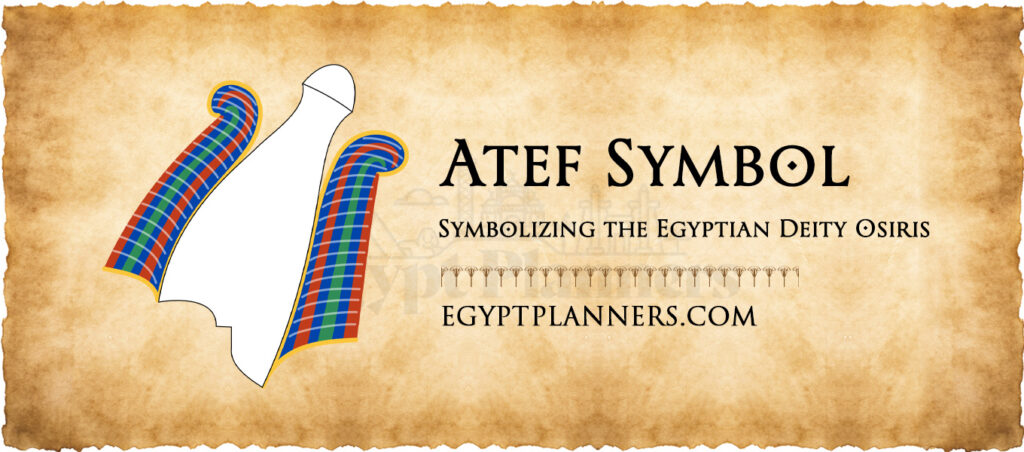
The Atef is an ancient Egyptian crown linked to the god Osiris. He ruled the underworld and was the god of resurrection and rebirth. It’s a tall white crown with ostrich feathers, ribbons, and ram horns.
This crown shows Osiris’s power over the afterlife and his role as the judge of the dead. It was seen in art and temple reliefs. It showed the hope for resurrection and eternal life in the underworld.
The Atef shows the ancient Egyptians’ belief in life’s cycle. They hoped for renewal and rebirth in the afterlife.
- Origin/Evolution: The Atef is closely tied to Osiris, but its exact start is unclear. It stands for his kingship of the afterlife and the land’s fertile power.
- Mythological/Ritual Usage: Pharaohs wore the Atef in ceremonies to link with Osiris. They hoped to gain his favor for their rule and afterlife.
27- Canopic Jars: Symbolizing Mummification and Protection
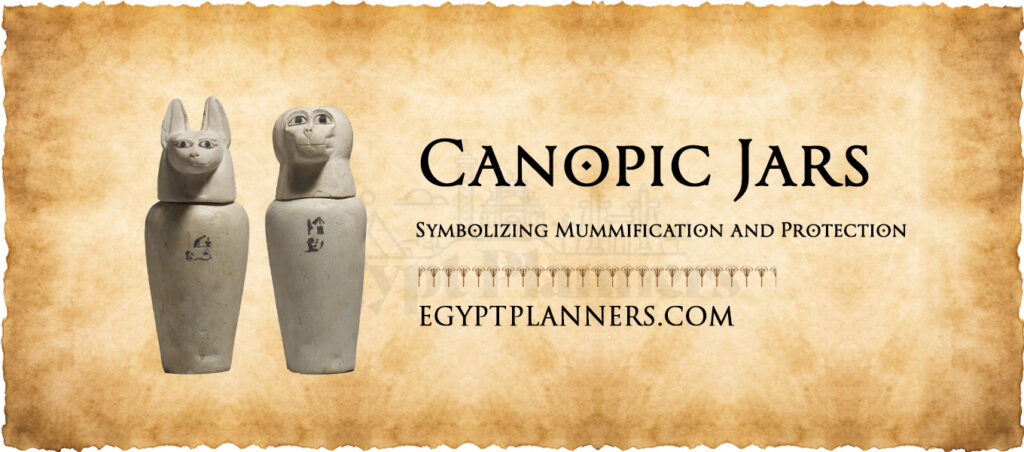
Canopic jars were used in ancient Egypt to keep organs of the dead. They were made from stone, pottery, or alabaster. These jars had fancy carvings and inscriptions.
Each jar was linked to one of the four sons of Horus. These sons protected the organs in the afterlife. The jars showed the Egyptians’ deep respect for the dead.
They were put in tombs with the mummy. This helped the deceased’s spirit and protected them on their journey to the afterlife.
- Origin/Evolution: Canopic jars started in the Old Kingdom and changed over time. They became linked to the sons of Horus in the Middle Kingdom.
- Mythological/Ritual Usage: The mummification rituals were complex. Each organ had a divine protector. The jars kept the body whole for the afterlife.
28- Sesen: Symbolizing the Sun, Rebirth, and Creation
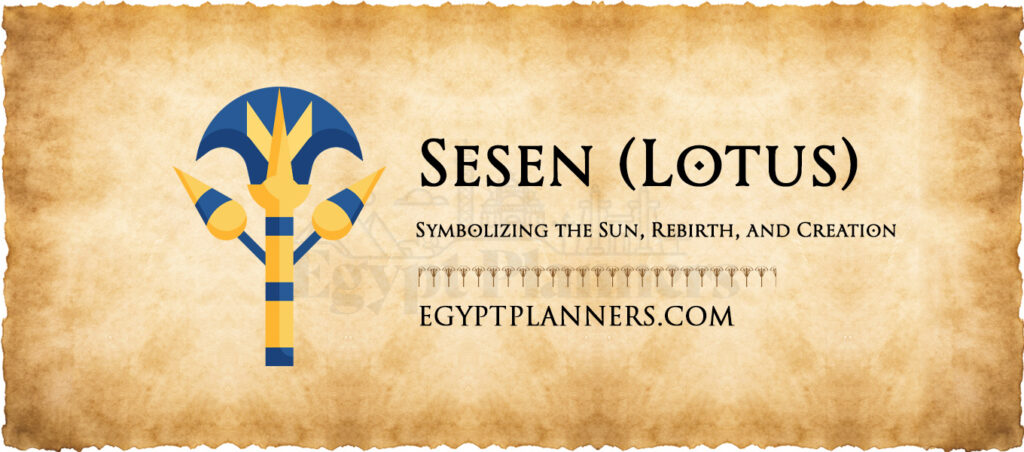
The Sesen is a key ancient Egyptian symbol. It represents the lotus flower, a plant sacred to the sun, rebirth, and creation. It shows the sun’s journey from dawn to dusk and its cycle of life and death.
The Sesen is tied to the goddess Isis. She was born from a lotus flower and used its petals to bring back her husband Osiris. This symbol was found in temples, tombs, and royal items. It shows the Egyptians’ deep respect for the sun and their belief in rebirth and renewal.
The Sesen stands for the endless cycle of life and death. It promises renewal and change in nature.
- Origin/Evolution: The lotus, linked with the sun and rebirth due to its daily opening and closing, became a potent symbol throughout Egyptian history.
- Mythological/Ritual Usage: The Sesen symbol was associated with creation myths and seen as an emblem of the life-giving power of the sun.
29- Sistrum: Symbolizing Music and Good Luck
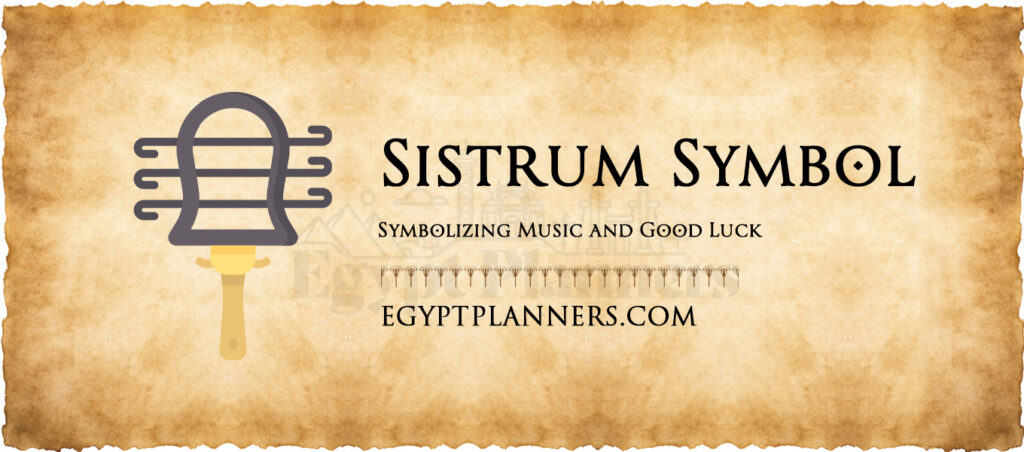
When shaken, the rods made a tinkling sound. This sound was believed to keep away evil spirits and bring the gods’ favor. The Sistrum stands for music, joy, and good luck in ancient Egyptian culture.
It was often shown in temple reliefs and tomb paintings. This showed the ancient Egyptians’ belief in music’s power to bring harmony and divine blessings. The Sistrum shows their deep respect for the divine and music’s power to evoke spiritual experiences and blessings.
- Origin/Evolution: Appearing around the New Kingdom, it likely evolved from earlier percussion instruments. It gains prominence in the Greco-Roman Period.
- Mythological/Ritual Usage: Strongly associated with Hathor, the goddess of music and joy. Its use appeased her and brought a joyful element to religious rituals.
30- Winged Sun: Symbolizing Solar Power and Eternity
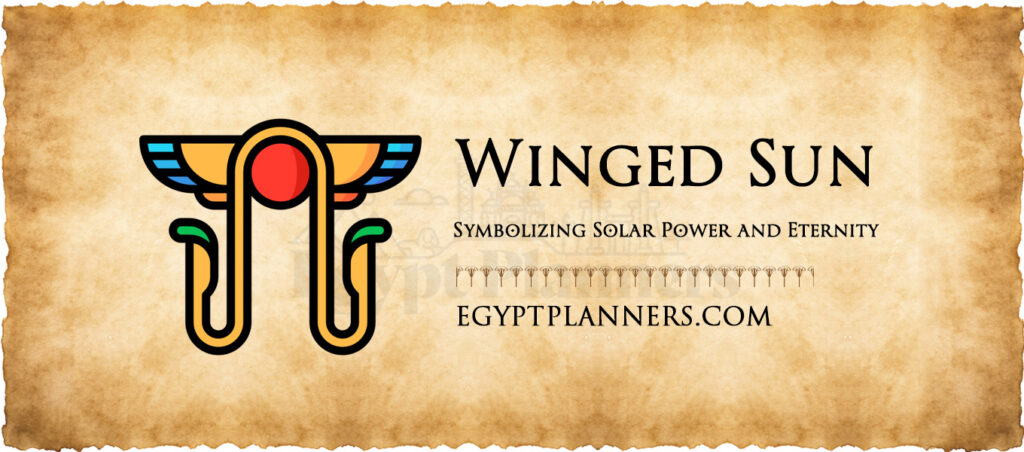
The Winged Sun is a key symbol from ancient Egypt. It shows the sun’s power and its endless life. It has a disk with wings on both sides, showing the sun’s journey across the sky.
This symbol is linked to the sun god Ra, often seen with wings. The Winged Sun means divine protection, enlightenment, and eternal life. It was found in temples, tombs, and royal clothes, showing the Egyptians’ deep respect for the sun.
They believed the sun brought life and renewal to the world. The Winged Sun shows their deep respect for the sun as a source of life and light. It also shows their belief in the sun’s power to renew and regenerate the universe.
Ancient Egyptian symbols of the soul
In ancient Egypt, the soul was seen as many parts, each with its own symbol. The Ka and the Ba were two key symbols.
The Ka was shown as a hieroglyph with arms out wide. It was the life force or spiritual power inside a person. The Ka stayed with the body after death, helping the person live on in the afterlife.
The Ka and Ba
The Ba was a bird with a human head. It stood for the person’s unique self. After death, the Ba could leave the body and go wherever it wanted. It could visit the tomb and the Ka.
The Egyptians thought keeping the Ka and the Ba safe was very important. They did things like mummify bodies and put statues and offerings in tombs. This helped the Ka and Ba have a place to stay and live in the next life.
“The ancient Egyptians believed that the soul was composed of several interconnected parts, with the Ka and Ba being two of the most significant symbols.”
These symbols of the soul and the afterlife were very important to the Egyptians. They showed their strong belief in life going on after the body stops.
Ancient Egyptian symbols of good luck
In ancient Egypt, symbols were key to finding luck and protection. The Scarab beetle was a top symbol, linked to the sun god Ra. It meant death, rebirth, and change. People used scarabs as amulets and seals, making different types for various needs.
The Cartouche was another lucky symbol, shaped like an oval and meant to protect against evil. It was tied to the Ouroboros, a snake eating its tail. This symbol showed life’s cycle and the sun’s path.
- The Lotus flower stood for wealth, fertility, and god’s favor, bringing luck.
- The Shen ring, symbolizing endlessness and safety, was held by gods like Horus and Isis. It kept harm away.
These symbols, like the Ankh, the Eye of Horus, and the Djed pillar, were highly valued. The Egyptians thought they could bring wealth, fertility, and divine blessings. The lasting impact of these Ancient Egyptian Good Luck Symbols still fascinates and motivates people today.
| Symbol | Meaning | Significance |
|---|---|---|
| Scarab | Transformation, immortality, resurrection | Linked to the sun god Ra and the dung beetle’s story |
| Cartouche | Divine protection, life cycle | An oval hieroglyphic nameplate, connected to the Ouroboros |
| Lotus Flower | Prosperity, fertility, rebirth | Related to the sun, rebirth, and life |
| Shen Ring | Infinity, completeness, protection | Often held by gods like Horus and Isis |
Ancient Egyptian symbols of Power & Strength
The ancient Egyptians had symbols full of deep meaning. These symbols showed the power and strength of the pharaohs and gods. They were a key part of their culture.
The Was Scepter was a staff with an animal head and a forked base. It showed the gods’ power and the pharaoh’s rule. The Djed Pillar looked like the “Backbone of Osiris.” It stood for stability, new life, and the gods’ creative power.
The Crook and Flail were symbols of the pharaoh’s power and rule. The Uraeus, a cobra, showed the pharaoh’s link to the gods.
| Symbol | Meaning | Significance |
|---|---|---|
| Was Scepter | Dominion of the gods and power of the pharaohs | Ensured the continuance of prosperity |
| Djed Pillar | Stability, regeneration, and creative powers of Osiris and Ptah | Represented the “Backbone of Osiris” |
| Crook and Flail | Royal power and the pharaoh’s authority over the people | Often depicted together as emblems of power |
| Uraeus | Divine authority and the connection between the ruler and the gods | Depicted as a rearing cobra on the pharaoh’s crown |
These symbols were not just for art and buildings. They were also key in religious acts. They helped show the pharaoh as a god and the symbol of Egypt’s symbols of Power & Strength.
Read our guides about:
Ancient Egyptian symbols of kingship
The ancient Egyptians were experts in symbolism. Their symbols of kingship showed the power and godliness of the pharaohs. They were key to their religious and cultural life.
The Double Crown, or Pschent, was a big symbol. It was made of the Red Crown of Lower Egypt and the White Crown of Upper Egypt. This crown showed the pharaoh ruled both kingdoms.
Other symbols were the Deshret (Red Crown) and the Hedjet (White Crown). These were for the rulers of Lower and Upper Egypt. The Crook and Flail were also symbols of power and the pharaoh’s rule.
The Uraeus, a cobra, showed the pharaoh’s divine power and link to the gods. These symbols were used in art and rituals. They made the pharaoh seem like a living god and Egypt strong.
| Symbol | Meaning | Significance |
|---|---|---|
| Double Crown (Pschent) | Unification of Upper and Lower Egypt | Represented the pharaoh’s rule over the whole country |
| Deshret (Red Crown) | Crown of Lower Egypt | Worn by rulers of Lower Egypt |
| Hedjet (White Crown) | Crown of Upper Egypt | Worn by rulers of Upper Egypt |
| Crook and Flail | Royal power and authority | Depicted together as symbols of the pharaoh’s control over their people |
| Uraeus | Divine authority and connection to the gods | Represented the pharaoh’s status as a living god |
These symbols of kingship were more than just decorations. They were deeply spiritual and cultural in ancient Egyptian society. They were key to the pharaoh’s role as Egypt’s power, stability, and link to the divine.
Ancient Egyptian symbols of the afterlife
The ancient Egyptians thought death was just the start of a new life. They used symbols to show the soul’s journey after death. Amenta was a key symbol, meaning the Underworld or land of the dead.
It linked to the western bank of the Nile, where they buried their dead. They thought this was the way to the Underworld.
Canopic jars held the dead’s organs during mummification. They were seen as needed for the soul’s afterlife journey. The Djed Pillar, linked to Osiris, stood for stability and rebirth. It showed the cycle of death and new life.
These symbols helped the Egyptians guide the soul safely into the afterlife. They made sure the deceased could live on with the gods. These symbols were key to their beliefs and preparations for the afterlife.
Conclusion: Ancient Egyptian symbols
The ancient Egyptian symbols we looked at show the deep beliefs of this amazing civilization. Symbols like the Ankh and Djed meant more than just pretty pictures. They held deep meanings about life and death.
These symbols helped the ancient Egyptians believe in an eternal journey. They used them to share their spiritual beliefs with others.
Today, these symbols still touch our hearts and minds. The Scarab beetle and the Eye of Horus are symbols of rebirth and protection. They show how ancient Egyptian culture still affects us.
By learning about these symbols, we see the beauty of their worldview. It helps us understand their beliefs and values. This shows us the power of ancient Egyptian culture.
In conclusion, these symbols open a window into ancient Egypt’s spiritual and cultural life. They show their deep connection to nature and their belief in life after death. These symbols remind us of the power of symbolism in expressing our deepest thoughts and dreams.
Resources to ancient Egyptian symbols and meanings
Don’t miss to check & read our related articles about Ancient Egypt:
